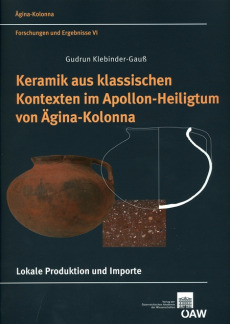Gudrun Klebinder-Gauß
Keramik aus klassischen Kontexten im Apollon-Heiligtum von Ägina-Kolonna
Lokale Produktion und Importe
Reihe herausgegeben von Manfred Bietak, Beiträge von Myrto Georgakopoulos, Reihe herausgegeben von Hermann Hunger, Beiträge von Evangelia Kiriatzi, Beiträge von Areti Pentedeka, Beiträge von Jörg Weilhartner
Reihe: Contributions to the Chronology of the Eastern Mediterranean, Denkschrift der GesamtakademieDie Insel Ägina mit ihrem gleichnamigen Hauptort war in der spätarchaischen und klassischen Periode ein wichtiges Zentrum in der zentralen Ägäis. Die Bedeutung und der Wohlstand Äginas resultierten aus der intensiven Handelstätigkeit seiner Flotte mit weit reichenden Verbindungen über den Saronischen Golf hinaus bis in das Schwarzmeergebiet, nach Nordafrika und Italien. Der vorliegende Band untersucht Keramik aus klassischen Kontexten im Gebiet des „Kolonna-Hügels“, der Akropolis der antiken Inselhauptstadt. Diese Kontexte enthalten neben einer Reihe von Importen, darunter solche aus Attika, Korinth, Lakonien, Ostgriechenland und der nördlichen Ägäis, auch zahlreiche Gefässe lokaler Herkunft. Neben der stilistischen und chronologischen Auswertung der Keramik und der daraus abgeleiteten Interpretation der Kontexte liegt der Schwerpunkt dieses Bandes auf der bislang wenig erforschten lokalen Keramikproduktion. Unter Miteinbeziehung naturwissenschaftlicher Untersuchungen und antiker Schriftquellen wird das Bild eines bedeutenden Produktionszentrums von Kochkeramik gezeichnet, das ein breites Formenspektrum entwickelte und seine Erzeugnisse weithin exportierte. Über die Untersuchung von stilistischen Entwicklungen der Keramik dieser Epoche hinaus wird auch eine Verbindung zur historischen und wirtschaftlichen Situation Äginas in klassischer Zeit hergestellt und seine Rolle als bedeutende Handelsmacht und Rivale Athens beleuchtet.
During the late Archaic and Classical periods the island of Aegina was a very important centre in the central Aegean. Its power and prosperity resulted from the intense trade activities of its fleet in the Saronic Gulf and beyond up to the Black Sea, North-Africa and Italy. This volume presents pottery from find contexts of the Classical period excavated in the area of the “Kolonna-hill”, the acropolis of the island’s ancient capital. The contexts discussed here, contain imported pottery, such as from Attica, Corinth, Laconia, Eastern Greece and from the Northern Aegean, and numerous vessels of local origin. The main emphasis of this volume is the careful analysis of the local pottery-production that thus far was a neglected research topic. With the help of supplementary scientific analysis and the interpretation of written sources on pottery production at Aegina the picture of an important production centre of cooking pottery emerges. The production flourished in the Classical period and a wide range of shapes was developed and exported to distant regions. Beyond the study of stylistic developments of the pottery of this period and the interpretation of the contexts in terms of chronology and function, the pottery is also analysed within the context of the political and economic situation of Aegina during the Classical period regarding its position as an important trade power and rival of Athens.

